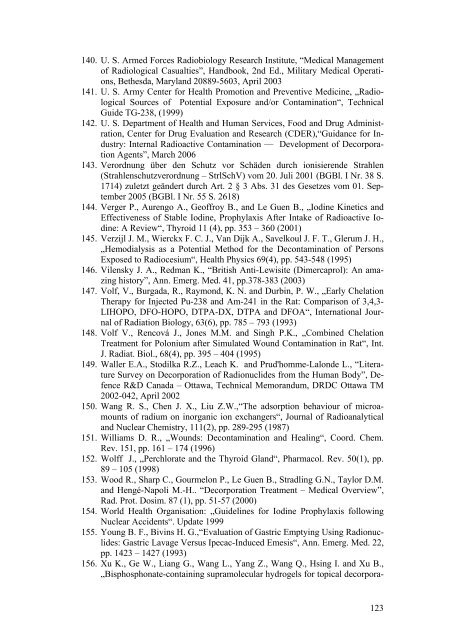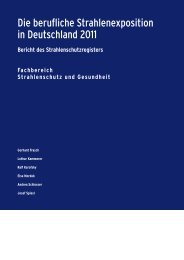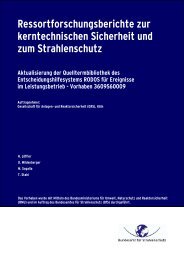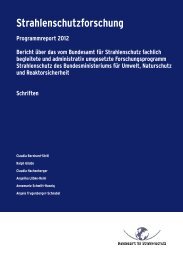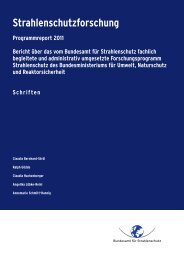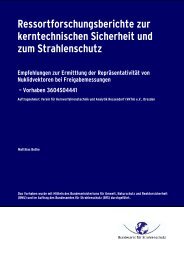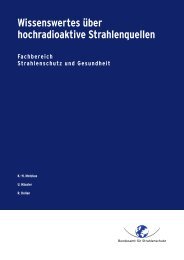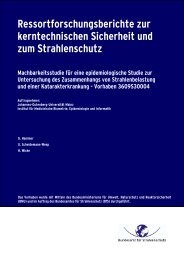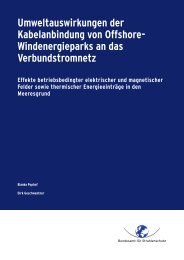Materialsammlung zur internen Radiodekontamination von Personen
Materialsammlung zur internen Radiodekontamination von Personen
Materialsammlung zur internen Radiodekontamination von Personen
Erfolgreiche ePaper selbst erstellen
Machen Sie aus Ihren PDF Publikationen ein blätterbares Flipbook mit unserer einzigartigen Google optimierten e-Paper Software.
140. U. S. Armed Forces Radiobiology Research Institute, “Medical Management<br />
of Radiological Casualties”, Handbook, 2nd Ed., Military Medical Operations,<br />
Bethesda, Maryland 20889-5603, April 2003<br />
141. U. S. Army Center for Health Promotion and Preventive Medicine, „Radiological<br />
Sources of Potential Exposure and/or Contamination“, Technical<br />
Guide TG-238, (1999)<br />
142. U. S. Department of Health and Human Services, Food and Drug Administration,<br />
Center for Drug Evaluation and Research (CDER),“Guidance for Industry:<br />
Internal Radioactive Contamination — Development of Decorporation<br />
Agents”, March 2006<br />
143. Verordnung über den Schutz vor Schäden durch ionisierende Strahlen<br />
(Strahlenschutzverordnung – StrlSchV) vom 20. Juli 2001 (BGBl. I Nr. 38 S.<br />
1714) zuletzt geändert durch Art. 2 § 3 Abs. 31 des Gesetzes vom 01. September<br />
2005 (BGBl. I Nr. 55 S. 2618)<br />
144. Verger P., Aurengo A., Geoffroy B., and Le Guen B., „Iodine Kinetics and<br />
Effectiveness of Stable Iodine, Prophylaxis After Intake of Radioactive Iodine:<br />
A Review“, Thyroid 11 (4), pp. 353 – 360 (2001)<br />
145. Verzijl J. M., Wierckx F. C. J., Van Dijk A., Savelkoul J. F. T., Glerum J. H.,<br />
„Hemodialysis as a Potential Method for the Decontamination of Persons<br />
Exposed to Radiocesium“, Health Physics 69(4), pp. 543-548 (1995)<br />
146. Vilensky J. A., Redman K., “British Anti-Lewisite (Dimercaprol): An amazing<br />
history”, Ann. Emerg. Med. 41, pp.378-383 (2003)<br />
147. Volf, V., Burgada, R., Raymond, K. N. and Durbin, P. W., „Early Chelation<br />
Therapy for Injected Pu-238 and Am-241 in the Rat: Comparison of 3,4,3-<br />
LIHOPO, DFO-HOPO, DTPA-DX, DTPA and DFOA“, International Journal<br />
of Radiation Biology, 63(6), pp. 785 – 793 (1993)<br />
148. Volf V., Rencová J., Jones M.M. and Singh P.K., „Combined Chelation<br />
Treatment for Polonium after Simulated Wound Contamination in Rat“, Int.<br />
J. Radiat. Biol., 68(4), pp. 395 – 404 (1995)<br />
149. Waller E.A., Stodilka R.Z., Leach K. and Prud'homme-Lalonde L., “Literature<br />
Survey on Decorporation of Radionuclides from the Human Body”, Defence<br />
R&D Canada – Ottawa, Technical Memorandum, DRDC Ottawa TM<br />
2002-042, April 2002<br />
150. Wang R. S., Chen J. X., Liu Z.W.,“The adsorption behaviour of microamounts<br />
of radium on inorganic ion exchangers“, Journal of Radioanalytical<br />
and Nuclear Chemistry, 111(2), pp. 289-295 (1987)<br />
151. Williams D. R., „Wounds: Decontamination and Healing“, Coord. Chem.<br />
Rev. 151, pp. 161 – 174 (1996)<br />
152. Wolff J., „Perchlorate and the Thyroid Gland“, Pharmacol. Rev. 50(1), pp.<br />
89 – 105 (1998)<br />
153. Wood R., Sharp C., Gourmelon P., Le Guen B., Stradling G.N., Taylor D.M.<br />
and Hengé-Napoli M.-H.. “Decorporation Treatment – Medical Overview”,<br />
Rad. Prot. Dosim. 87 (1), pp. 51-57 (2000)<br />
154. World Health Organisation: „Guidelines for Iodine Prophylaxis following<br />
Nuclear Accidents“. Update 1999<br />
155. Young B. F., Bivins H. G.,“Evaluation of Gastric Emptying Using Radionuclides:<br />
Gastric Lavage Versus Ipecac-Induced Emesis“, Ann. Emerg. Med. 22,<br />
pp. 1423 – 1427 (1993)<br />
156. Xu K., Ge W., Liang G., Wang L., Yang Z., Wang Q., Hsing I. and Xu B.,<br />
„Bisphosphonate-containing supramolecular hydrogels for topical decorpora-<br />
123


